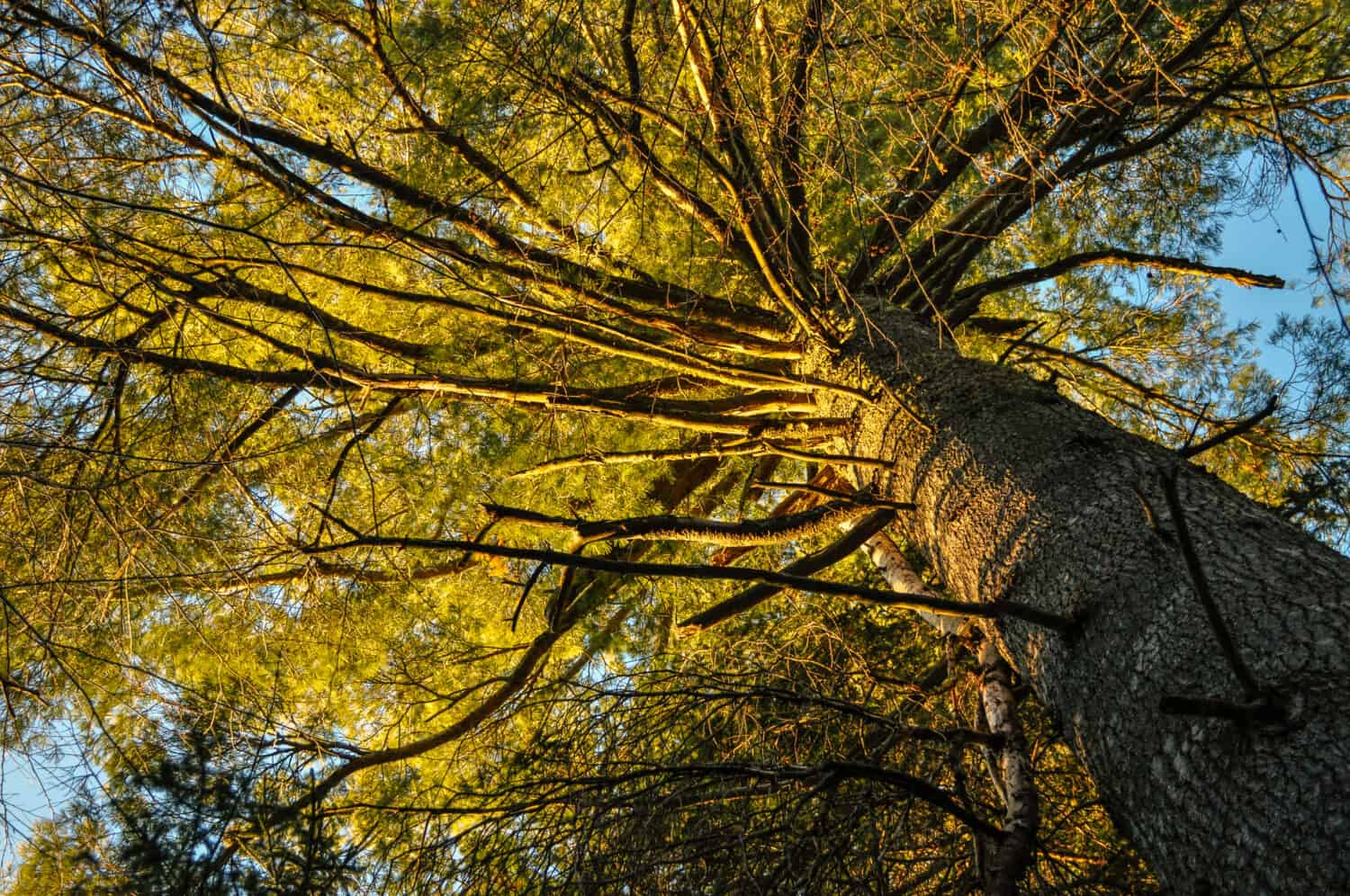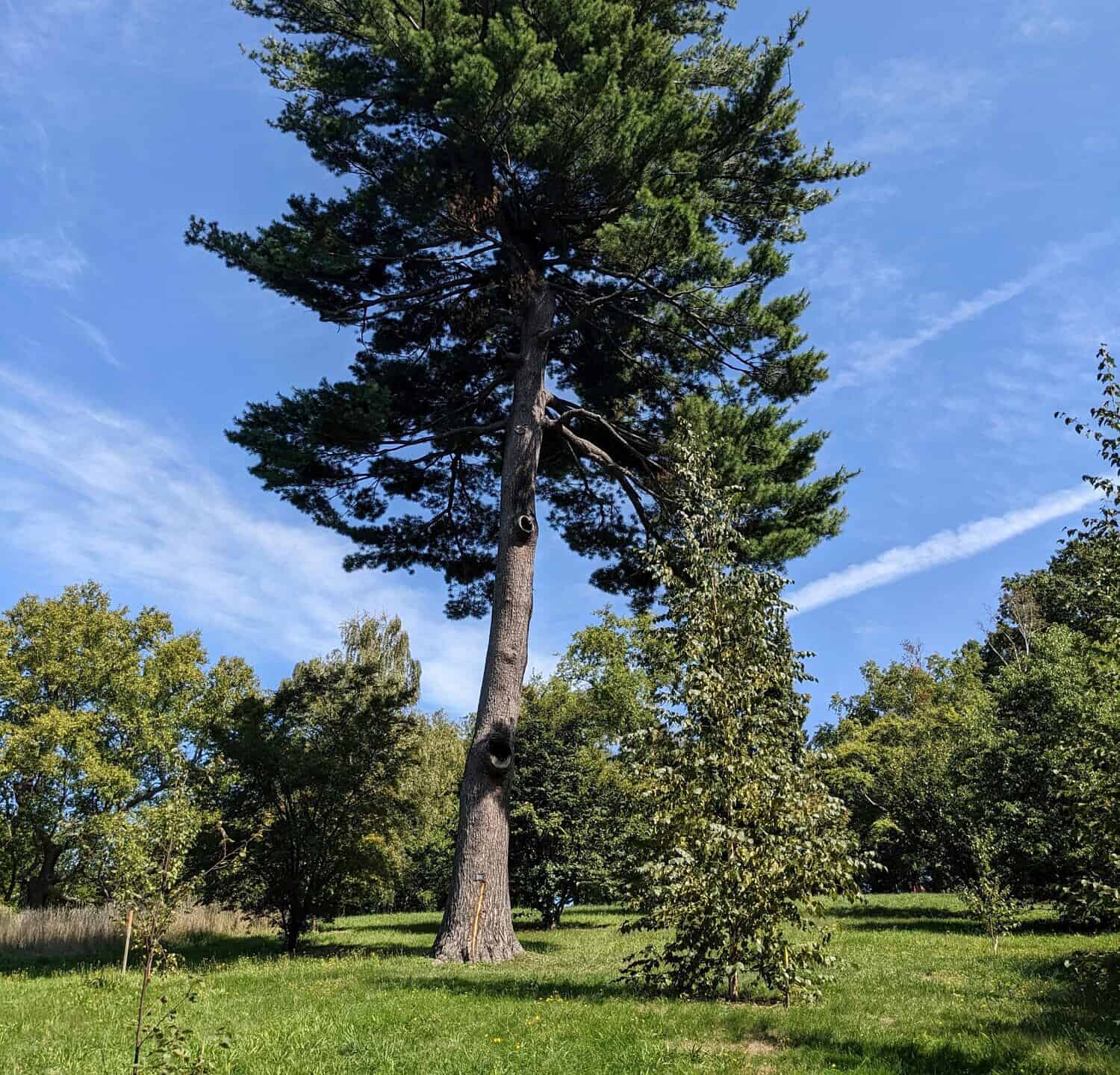Of the many natural wonders in the state of New York, one of the most prominent is its vast forests with towering trees. From the Adirondack Mountains in the north to the Hudson Valley in the south, New York’s diverse landscape boasts many trees that can grow to great heights. But with so many trees to choose from, which one stands as the tallest in the state?
Join me as we take a journey to discover the tallest tree in New York State and explore the unique qualities that make it stand tall above the rest!
Discover the Tallest Tree in New York State – A Towering 174-Foot Goliath!

Evening light on a white pine, pinus strobus, in the Adirondack Mountains of New York State.
©Bob Grabowski/Shutterstock.com
The tallest known tree in New York State has changed over time due to trees falling and new discoveries. In 2021, the white pine known as Tree 103, which stood in a grove and was last measured at 160 ft., fell down. However, in June 2022, a new giant tree was discovered near Bolton, believed to be New York’s tallest measured tree at 174 feet, a white pine rising above hundreds of giants. Therefore, as of June 2022, the tallest known tree in New York State is the 174-foot white pine discovered near Bolton.
Characteristics Of The White Pine Tree:

The white pine tree is a remarkably tall species of evergreen tree found in
North America
.
©Chris Dale/Shutterstock.com
With its towering height and distinct needle structure, the white pine tree is a remarkable species of evergreen conifers found in North America. Growing rapidly up to 60 meters in height, this tree has long, slender needles that grow in bundles of five, setting it apart from other eastern pines. Its straight trunk and pyramidal crown give it a majestic appearance, complemented by the thin, scaly, grayish-brown bark when young that develops into a reddish-brown color with age.
The white pine produces narrow cylindrical cones up to 8 inches long, with a yellowish-brown hue. It has various uses, including windbreaks, Christmas trees, and landscape management, thanks to its easy transplants. Overall, the white pine tree remains an important and distinctive tree that contributes significantly to the beauty of the natural environment.
What Is The History Of The White Pine Tree In New York State?
The white pine tree has a rich history in the state of New York. It was one of the most important tree species in the state for its timber and played a significant role in the state’s forest industry in the 19th and early 20th centuries. In 1902, New York State’s tree nursery system was founded, with white pine being among the tree species planted in state forests.
The white pine also holds a cultural and symbolic significance among Native American tribes, which we will discuss further below. Overall, the white pine tree has a storied history in New York State, with significant historical, cultural, and ecological importance.
What Is The Historical Significance Of The White Pine Tree To Native American Tribes?
the white pine tree is culturally and symbolically significant to many Native American tribes, including the Haudenosaunee and Mohawk, who regard it as the “Tree of Peace.” The white pine is significant in Native American mythology and holds ceremonial and medicinal importance. For example, the inner bark of the white pine was eaten by Native Americans during times of famine since it was rich in nutrients.
Native American tribes also used white pine needles to make tea, which served as a remedy for various ailments, such as colds and coughs. The white pine tree was also used for constructing homes, canoes, and various tools. Overall, the white pine tree has played a vital role in Native American culture and remains a symbol of peace, strength, and resilience.
How Did The Battle Over Ownership Of White Pines Contribute To The Revolutionary War?
The battle over the ownership of white pines played a role in the Revolutionary War as it was a catalyst for colonial resistance against British authority. To protect Britain’s naval and trade advantage, laws were passed in North America that specifically protected selected white pines for British shipbuilding, including the mast pines, which were vital for the production of masts for British ships. However, the colonists saw this as an infringement of their rights, and many resisted the laws, leading to confrontations and tensions with British authorities.
The Pine Tree Riot of 1772 in New Hampshire, where colonists forcibly prevented a British agent from marking white pine trees for British use, was one of the most significant events that led to the Revolutionary War. Additionally, the story of the white pine and its ownership was compared to the Stamp Act and the Tea Act, further highlighting its historical significance in the events leading up to the Revolutionary War.
What Are Some Common Uses Of White Pine Timber In New York State?

Pinus strobus, or white pine, is the tallest type of tree in New York.
©andysartworks/Shutterstock.com
The white pine timber has been historically important in New York State and has been used for a variety of purposes. Some common uses of white pine timber in New York State include:
Shipbuilding: White pine was commonly used for shipbuilding, particularly mast production, due to its strength and straight grain.
Construction: White pine was also widely used for construction purposes due to its structural strength and durability.
Furniture: White pine wood was commonly used for making furniture and cabinetry, as it is lightweight and easy to work with.
Flooring: The soft texture and resilience of white pine made it a popular choice for flooring.
Pulp and paper: White pine was also used to produce pulp and paper products.
Railroads: White pine was used for railroad ties in the late 19th and early 20th centuries.
How Has Land Use Affected The Growth Of White Pines In New York?
Historical land use changes have affected the growth of white pines in New York. Land use patterns that resulted in deforestation, such as logging and agriculture, had a significant impact on white pine populations. Large tracts of white pine forests were harvested for their timber, resulting in the loss of many mature trees.
Also, the use of heavy machinery to clear land for farming and development damaged white pines by compacting soil and altering drainage. However, more recent management practices have attempted to restore and preserve white pine populations in New York by controlling pests and diseases, reforestation, and selective harvesting practices that protect mature pines.
How Is The White Pine Tree Being Protected In New York?
White pine trees are being protected in New York through various conservation and management efforts. The New York State Department of Environmental Conservation (DEC) employs multiple programs to manage and protect white pine forests, including reforestation, pest and disease control, and selective harvesting practices. The DEC also monitors the spread of invasive pests, such as the Southern Pine Beetle, which can damage white pines. In addition, organizations such as the Central Park Conservancy contribute to conservation efforts by planting and maintaining white pine trees in urban areas.
White pine trees are also being protected through education and outreach programs that encourage landowners to plant and care for white pines on their property. Protective measures, such as pruning lower branches and applying fungicide treatments, can also be taken to maintain the health of white pine trees. Overall, the conservation of white pine trees in New York involves a combination of management practices, public education and outreach, and monitoring efforts to promote the growth and health of white pine populations.
Where is Bolton, New York Located on a Map?
Bolton is a town located in Warren County, New York, it is an integral part of the Glens Falls Metropolitan Statistical Area. Positioned on the eastern border of the county, Bolton enjoys a picturesque setting in beautiful upstate New York.
Here is Bolton, New York on a map:
In Conclusion
The white pine tree holds a significant place in the history and ecology of New York State. As the state’s tallest tree species, the white pine has played a vital role in timber production, shipbuilding, and many other applications such as producing paper and furniture. White pines have also been impacted by land use changes, particularly deforestation, but efforts to restore and protect white pine forests have been underway for decades.
Today, white pines in New York are being managed and conserved through various programs and initiatives aimed at preserving their unique ecological and cultural importance. Overall, the rich history, cultural significance, and ecological importance of the white pine make it a valuable part of New York’s natural heritage that should be celebrated and protected for future generations.
The photo featured at the top of this post is © RAW-films/Shutterstock.com
Thank you for reading! Have some feedback for us? Contact the AZ Animals editorial team.







